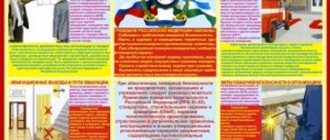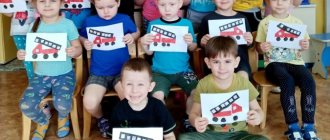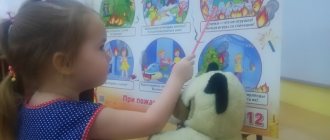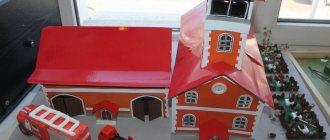In preschool educational institutions, special attention must be paid to fire safety, teaching children the rules of behavior in case of fire, and fire protection of premises.
This section , fire safety in a preschool educational institution, reveals the requirements for the administration and employees in terms of fire safety in 2021 and defines the rules for the safe operation of the kindergarten.
Fire safety in kindergartens is systematically under the control of the administration; teaching staff are required to conduct briefings and conversations with students on fire safety rules for children in preschool educational institutions.
In this section you can download new instructions on fire safety in preschool educational institutions (2021), developed in accordance with Decree of the Government of the Russian Federation of September 16, 2021 No. 1479 “On approval of fire safety rules in the Russian Federation”, which came into force on January 1, 2021 of the year; instructions and magazines on fire safety, as well as orders, acts and protocols on fire safety in kindergartens.
The goal of each developed fire safety instruction in a kindergarten is to prevent a fire hazard, to prevent a fire in a preschool educational institution, at home and on the street, to preserve the health and lives of children.
Instructions for fire safety in preschool educational institutions
Basic instructions on fire safety measures in preschool educational institutions, fire safety instructions for administration, employees, procedures for action in case of fire, etc. are presented.
The head of the kindergarten is responsible for fire safety and fire protection in the preschool educational institution. He may, by order, appoint a person responsible for fire safety in the institution. It is mandatory that those in charge must develop instructions on fire safety measures in preschool educational institutions (kindergarten), as well as in warehouses, in the catering department, in the sports and music halls. download: Documentation on Fire Safety in Preschool Educational Institutions 38 documents taking into account laws as of September 8, 2021!
- Instructions on fire safety measures in preschool educational institutions
- Instructions on fire safety measures in the catering department of preschool educational institutions
- Instructions on fire safety measures in a food warehouse in a preschool educational institution
- Instructions on fire safety measures in the warehouse of inventory and goods and materials in preschool educational institutions
- Instructions on fire safety measures in the laundry room of a preschool educational institution
- Job description for fire safety of the head of a preschool educational institution
- Job description of the person responsible for fire safety
- Fire safety instructions for the duty administrator of a preschool educational institution
download: Regulations for preschool educational institutions 84 regulations in a package or individually. Update date: 10/06/2021
It is very important to bring to the knowledge of all kindergarten employees the provisions of the instructions on the procedure for maintaining and bringing the premises of the preschool educational institution to a fire-safe condition in order to prevent fires in classrooms and flooding.
Requirements for escape routes
When operating evacuation routes Click to go to FireWiki, evacuation Click to go to FireWiki and emergency exits Click to go to FireWiki it is prohibited:
a) install thresholds on escape routes (except for thresholds in doorways), install sliding and up-and-down doors and gates without the ability to manually open them from the inside and lock them open, revolving doors and turnstiles, as well as other devices that prevent free evacuation people, in the absence of other (duplicate) escape routes or in the absence of technical solutions that allow manually opening and locking the specified devices in the open state. In addition to the manual method, it is allowed to use an automatic or remote method of opening and locking devices;
b) place (install) on evacuation routes and emergency exits (including in passages, corridors, vestibules, galleries, elevator halls, landings, flights of stairs, doorways, evacuation hatches) various products, equipment, waste, garbage and other objects that impede safe evacuation, as well as block the doors of emergency exits;
c) arrange dryers and hangers for clothes, wardrobes in the vestibules of exits from buildings (except for apartments and individual residential buildings), as well as store (including temporarily) equipment and materials;
d) fix self-closing doors of staircases, corridors, halls and vestibules in the open position (unless devices that automatically trigger in case of fire are used for these purposes), and also remove them;
e) change the direction of door opening, with the exception of doors whose opening is not regulated or for which other requirements are imposed.
In addition, it should be noted that at sites with large numbers of people, the head of the organization ensures the availability of serviceable hand-held electric flashlights at the rate of at least 1 flashlight for each person on duty and personal protective equipment for the respiratory organs and vision of a person from fire hazards at the rate of at least 1 personal protective equipment protection of human respiratory organs and vision from dangerous fire factors for each duty officer.
Also, evacuation plans must be posted at the facility, which must be practiced during fire drills at least once every six months.
The rules state that the facility must have evacuation routes that comply with established standards for illumination, quantity, size, etc.
Fire safety instructions in kindergarten
Officials and employees of a preschool educational institution must clearly know the procedure for action in the event of a fire and evacuation in order to evacuate children in a timely and safe manner, notify the fire service and the head of the preschool educational institution in a timely manner, and take appropriate measures to extinguish the source of fire in the absence of a threat to life.
download: Job descriptions for preschool educational institutions (Profstandard) 31 instructions individually and in packages, updated - September 5, 2021!
- Fire safety instructions for preschool employees
- Instructions on the procedure for officials to act in the event of a fire in a preschool educational institution
- Instructions on the actions of personnel during evacuation in case of fire in a preschool educational institution
- Instructions on the procedure for maintaining and bringing premises of preschool educational institutions to a fire-safe condition
- Instructions for fire safety during mass events
- Fire safety instructions for New Year's events
- Fire safety rules for children in preschool educational institutions
- Fire safety rules for children at home
- Procedure for employees to evacuate in the event of a fire at a preschool educational institution
- Instructions on fire safety measures during repair work of preschool educational institutions
- Instructions on fire safety measures when carrying out painting work at preschool educational institutions
- Instructions for fire safety when carrying out hot work at preschool educational institutions
Learn fire safety rules
Action plan for children of senior preschool age.
Our little fidgets are in a hurry to explore the world, not realizing the danger that it can bring. And we, adults, cannot always be there to help. That is why it is necessary to develop in children a conscious and responsible attitude towards personal safety and the safety of others. And in this sense, it is very important to introduce them to fire safety rules before school.
Every year we conduct a series of safety events in our kindergarten, the purpose of which is to develop in children the skills of careful handling of fire and an understanding of the need to comply with fire safety rules.
Tasks
- Give children initial information about the causes of a fire.
- Introduce the properties and qualities of objects in terms of their fire hazard.
- Give an idea of the work of firefighters and their professional actions.
- Teach children the rules of safe behavior in the event of a fire: be able to navigate the space of a group room, apartment, know the first actions in the event of a fire, be able to call the rescue service “01”.
- Develop a cautious attitude towards objects that are high sources of fire hazard.
- Foster respect for the firefighting profession.
- Foster a desire to provide mutual assistance and take care of your life and health.
The formation of the foundations of children’s life safety is carried out in different directions, the main ones being work with children, parents, teaching staff and staff. It is important not only to protect the child from danger, but also to prepare him to face possible difficulties, to form an understanding of the most dangerous situations, the need to take precautions, and to instill in him the skills of safe behavior in everyday life together with his parents, who act as role models for the child.
April
I. Methodological work
1. Work with children.
A. Organized educational activities:
- Reading fiction. Cognition. Safety. Communication. Reading the poem by S. Marshak “The Story of an Unknown Hero.”
- Cognition. Safety. Communication. Conversation “Why does a fire occur?”
- Cognition. Safety. Communication. Conversation “If there is a fire in the house.”
- Cognition. Work. Safety. Communication. Conversation “Firefighter is a heroic profession.”
- Cognition. Work. Communication. Excursion to the fire station. Introducing the fire truck.
- Artistic creativity. Cognition. Reading fiction. Safety. Communication. Drawing based on impressions from the work read and from the excursion. X Reading fiction. Cognition. Safety. Communication. Reading the work of S. Marshak “Cat’s House”.
- Work. Cognition. Socialization. Reading fiction. Communication. Joint activities with the teacher. Making masks for the dramatization game “Cat House”.
B. Independent activities of children:
- Physical Culture. Socialization. Health. Outdoor game “Who is faster?”
- Socialization. Cognition. Safety. Communication. Didactic game “Objects are sources of fire.”
- Socialization. Cognition. Safety. Communication. Role-playing game “We are firefighters.”
- Cognition. Socialization. Safety. Communication. Didactic game “What does a firefighter need?”
B. Cultural and leisure activities:
- An evening of entertainment. Cognition. Reading fiction. Safety. Communication. Dramatization game "Cat's House".
- An evening of entertainment. Cognition. Safety. Communication. Quiz "Fire is the enemy."
- Artistic creativity. Cognition. Safety. Communication. Drawing. Exhibition of children's works "Fire: friend or foe?"
2. Interaction with personnel.
- Thematic exhibition “Introducing fire safety rules to preschoolers.”
- Instruction “Protecting the life and health of children.” X Design of the “Service 01” stand.
II. Interaction with parents
- Consultation: “Personal safety of the child.”
May
I. Methodological work
1. Work with children.
A. Organized educational activities:
- Reading fiction. Cognition. Safety. Communication. Reading of E. Khorinsky’s poem “The Little Match.”
- Cognition. Safety. Socialization. Music. Reading fiction. Communication. “Matches are not for playing.”
- Cognition. Safety. Communication. Excursion to the laundry. Introduction to the operation of an electric iron.
- Cognition. Safety. Socialization. Reading fiction. Communication. “Don’t dry your pants over the gas after washing, otherwise your pants will leave holes!”
- Cognition. Safety. Communication. Conversation “So that there is no fire.”
- Cognition. Safety. Communication. Conversation “If there is a fire in the house. Phone 01.”
- Safety. Cognition. Socialization. Communication. Training games to develop children's safe behavior skills.
B. Independent activities of children:
- Safety. Cognition. Socialization. Communication. Didactic game “It burns - it doesn’t burn.”
- Physical Culture. Health. Socialization. Outdoor game "Fast and dexterous."
- Safety. Cognition. Socialization. Communication. Didactic game “What can’t be done in the absence of adults?”
- Socialization. Cognition. Safety. Communication. Role-playing game “We are firefighters.”
- Safety. Cognition. Socialization. Communication. Didactic game “In the world of dangerous objects.”
- Socialization. Cognition. Safety. Health. Communication. Role-playing game “Hospital” (providing first aid to a fire victim).
B. Cultural and leisure activities:
- Artistic creativity. Cognition. Safety. Communication. Drawing. Children's drawing competition "Fire is a friend, fire is an enemy."
- An evening of entertainment. Cognition. Safety. Communication. Quiz “Take care of your house from fire!”
2. Interaction with personnel.
- Thematic exhibition “Fire Safety”.
- Organization of a practical lesson “Evacuation of children in case of fire.”
II. Interaction with parents
- Consultation: “Rules of conduct and actions in fire conditions.”
- Design of a thematic exhibition (from joint works of students, parents and teachers) “Take care of nature from fire!”
Lidiya Glazkova, senior teacher of the MBDOU
“Kindergarten for general developmental type “Vasilyok”, r.p. Mullovka, Melekessky district, Ulyanovsk region







